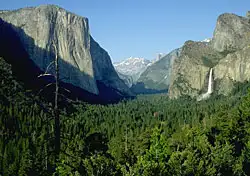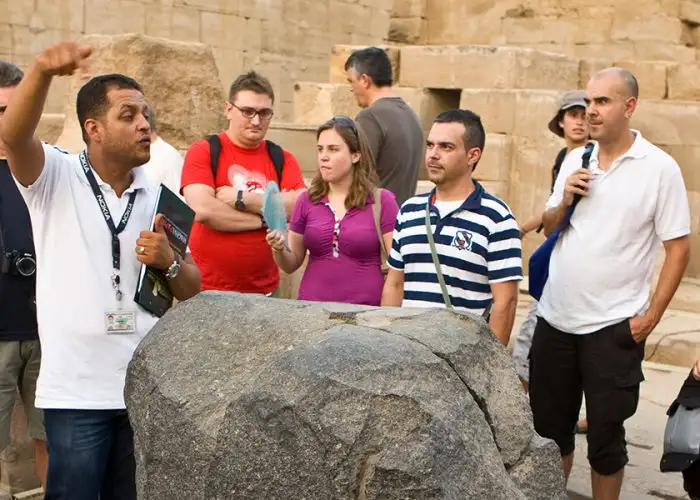
Yosemite National Park is open to visitors 24 hours a day, 365 days a year, but the experience can differ dramatically from season to season. Figuring out what you want (or want to avoid) from a visit can help you choose the best time to go.
Each season offers its own benefits and compromises. The elements that can make or break a vacation—crowds, availability, price, accessibility, and activities—change significantly throughout the year. Here’s what to expect from the four seasons of Yosemite.
Yosemite in summer
- Good for: Bicycling, swimming, rafting, total park access, wildflower blooms, camping
- Bad for: Easy booking, traffic-free driving, waterfall watching
Summer offers the best and worst of Yosemite. The whole park is accessible during the warm months, the wildflowers are in bloom, stargazing is at its most dazzling, and warm-weather activities are in full swing. It’s also by far the most crowded time to visit, and it’s easy to be disappointed or frustrated by the crowded hiking trails, packed vantage points, sold-out campgrounds, and car-choked valley roads.
There are ways to avoid the massive summer crowds, though. The easiest way is to explore the park in the early morning. Park ranger Adrienne Freeman says, “Even on the most crowded holiday weekend, those who get up early to walk and hike will have the valley to themselves.” Early morning is also one of the best times of day to spot wildlife.
Another trick to managing the summer throng is to stick to the less crowded east end of the valley, and then walk or take the shuttle to avoid getting stuck in daytime valley traffic. Exploring outlying areas of the park is another way to enjoy a more peaceful summer in Yosemite.
Finding a place to stay is the most challenging aspect of a summer trip. Accommodations reservations can be made 366 days in advance, and campsite reservations open up five months ahead of time.
Campsite reservations between May and September are booked within a few hours of becoming available. Some sites are available on a first-come, first-served basis, but even those often fill up by noon during the busy months. Summer is also the only time Tuolumne Meadows, White Wolf Lodge, and High Sierra facilities are open.
Next>> Yosemite in fall: Mild weather, but…
Yosemite in fall
- Good for: Mild weather and smaller crowds
- Bad for: Waterfall watching
Neither as crowded as summer nor as cold as winter, fall offers a good balance of mild weather and fewer visitors. The whole park remains accessible throughout most of the season, and slightly cooler temperatures make outdoor activities such as hiking and rock climbing more comfortable. Summer activities such as bicycling, horseback riding, guided night walks, and art classes continue to run through the season.
Fall is more than just summer with more elbow room, though. It’s also when the dogwood and maple trees turn vibrant colors and when you can choose between campfire programs near Curry Village or fireside storytelling evenings in the Ahwahnee. There’s also the annual Vintner Holiday multi-day programs, which run in the late fall, and are elaborate affairs featuring wine tastings, seminars with wine experts, and gala dinners.
Off-season accommodation rates kick in at the end of October, but the savings can vary drastically from property to property. For instance, the Ahwahnee lists the same rates at all times of the year, Yosemite Lodge has a $58 difference between in-season rates and midweek off-season prices, and Curry Village offers seasonal pricing for some lodging types but not for others. Motels, resorts, and B&Bs near the park may also adjust rates seasonally.
Next>> Yosemite in winter: Have less of the park, but have it to yourself
Yosemite in winter
- Good for: Winter activities, smallest crowds, least expensive accommodations
- Bad for: Exploring the whole park
Winter in Yosemite is a whole different world. Chilly temperatures and the fewest visitors of the year turn it from a bustling national park into a snowy wilderness. “The valley feels more untamed and wild in winter,” says Nancy Raff, who visits every January with her family. “There’s nothing better than taking a long hike in the fresh snow, not passing another person, and then returning to the fireplace at the Ahwahnee.”
Roaring fires, winter sports, and hot chocolate lure winter visitors, who can find cheaper rates and more last-minute availability at park accommodations. Winter prices are the lowest of the year at the Yosemite Lodge, Curry Village, and the Wawona. Even cheaper (and much colder) are the four campgrounds that remain open through winter: Wawona, Hodgdon Meadow, and two in Yosemite Valley.
The major drawback to a winter trip is the restricted road access to parts of the park. Tioga, Glacier Point, and Mariposa Grove roads are generally closed from November through April or May. However, the Yosemite Valley, Wawona, and Hetch Hetchy areas of the park remain accessible throughout winter, though visitors should bring tire chains and be prepared for winter driving conditions.
There’s no shortage of activities and programs in the coldest months. In the valley, ice skating and snowshoeing, along with year-round options such as camera walks and ranger talks, are available. And at the Badger Pass ski area, winter visitors can choose from cross-country and downhill skiing, snowboarding, snowshoeing, and tubing. The resort also offers multi-day cross-country ski trips, Trans-Sierra ski tours, and snow camping.
Badger Pass has discounted midweek rates, free passes for children under six, and youth and senior rates. There’s a free shuttle between the resort and the valley. And, the Yosemite Winter Association membership and benefit card includes three lift tickets, three ice skating passes, and a host of other benefits for less than the cost of a single day’s lift ticket.
Winter, when the snow records tell-tale tracks, is an ideal time to spot year-round residents such as coyotes and deer. And though spring is the time to see the waterfalls at their grandest, the falls are active in winter and it’s the time of year to see tall snow cones at upper Yosemite Falls.
Next>> Yosemite in spring: Babies, blooms, and big big waterfalls
Yosemite in spring
- Good for: Waterfalls, smaller crowds
- Bad for: Exploring the whole park
Spring brings abundance to Yosemite. Waterfalls are at their peak, the dogwoods are in bloom, and the newest generations of offspring are making their debuts. Spring visitors will also find fewer crowds and less competition for accommodations. However, limited park access remains an issue through the end of May on roads such as Tioga and Glacier Point.
Yosemite is known for its high concentration of impressive waterfalls, and spring is the absolute best time to witness the spectacle of Yosemite Falls, Bridalveil, Vernal, and Nevada falls. And, winter and spring are the only times to see the seasonal Ribbon, Horsetail, and Staircase falls. Spring is also the time to get a glimpse of lunar rainbows at the bridge at the base of lower Yosemite Falls on clear full-moon nights.
Spring visitors can also take advantage of both winter and summer activities. Still available through the end of the season are winter’s evening fireside storytelling and open-house family afternoon events. Summer activities such as biking, guided dusk and night walks, horseback riding, golfing, and art classes are offered as well.
In April, campsites start to fill up, though visitors can ensure space by booking in advance or arriving early at first-come, first-served sites. At lodges, high-season rates usually start in March, so spring doesn’t offer much in the way of reduced prices. However, booking should be easier, and visitors may have more choice about the type of room or package available. Visitors can sign up to receive occasional announcements about special rates at various facilities.
Any time of year
Regardless of the season, the park entry fee is $20 per car, good for seven days. There are also two annual passes good for repeat visits: $40 for a year’s Yosemite pass or $50 for an annual national parks pass. People 62 or older can purchase a Golden Age National Parks pass for $10. And those who manage to arrive at the gates of Yosemite by foot, horse, or motorcycle will need to pay only $10 for a seven-day pass.
Yosemite is no one-trick pony. In every season there’s a compelling reason to visit. First-time visitors may still prefer to head there in the height of summer, but those who want to discover the wealth of the park will do well to explore the four seasons of Yosemite.
We hand-pick everything we recommend and select items through testing and reviews. Some products are sent to us free of charge with no incentive to offer a favorable review. We offer our unbiased opinions and do not accept compensation to review products. All items are in stock and prices are accurate at the time of publication. If you buy something through our links, we may earn a commission.
Related
Top Fares From Columbus, OH
Today's Top Travel Deals
Brought to you by ShermansTravel
Shop and Save with Country Inns...
Patricia Magaña
 Hotel & Lodging Deals
Hotel & Lodging Deals
$229 -- Chicago: Discounted Rates and...
Francesca Miele
 Hotel & Lodging Deals
$229+
Hotel & Lodging Deals
$229+
$188 -- Honolulu: Save on Oceanview...
Abigail Lamay
 Hotel & Lodging Deals
$188+
Hotel & Lodging Deals
$188+






